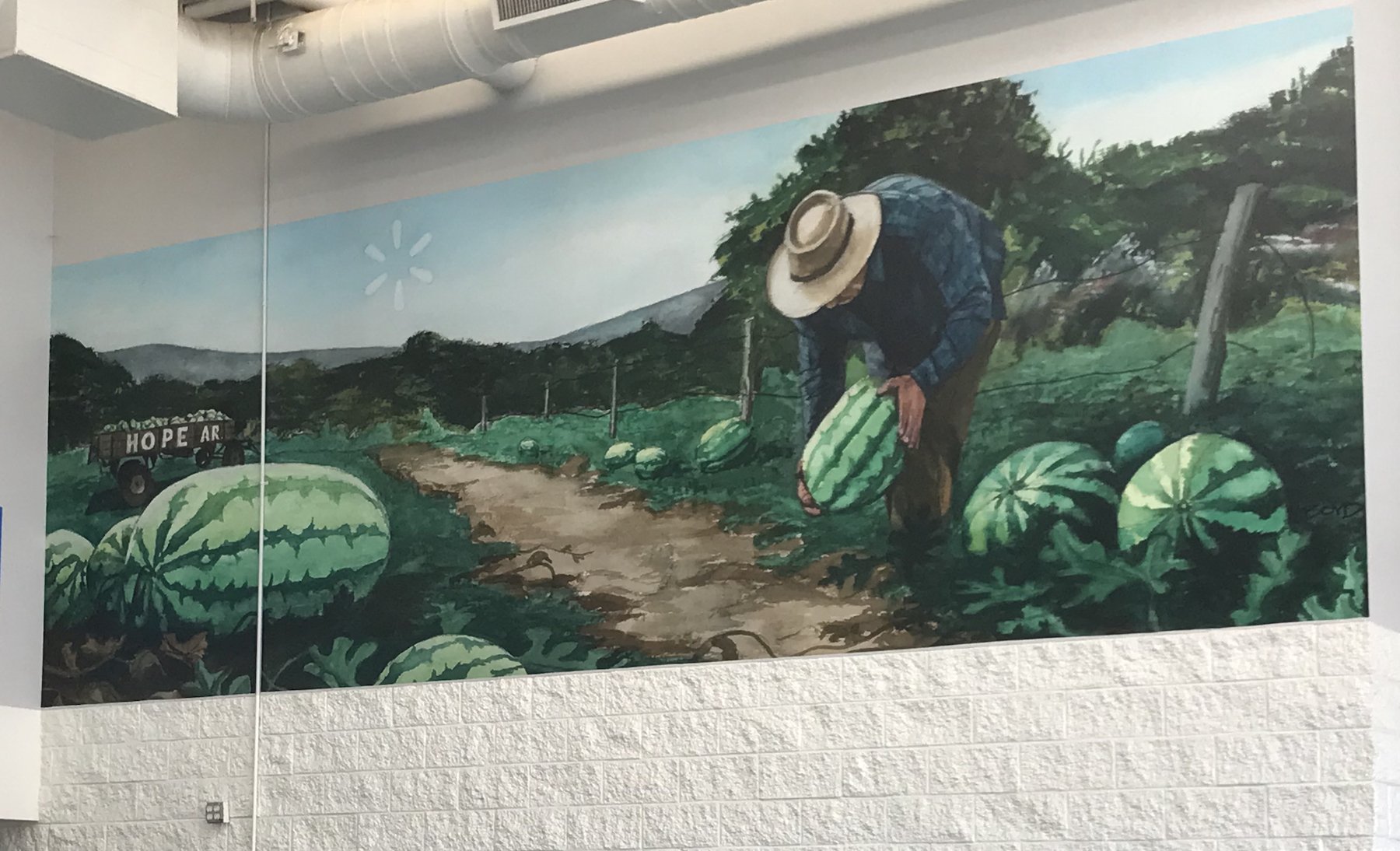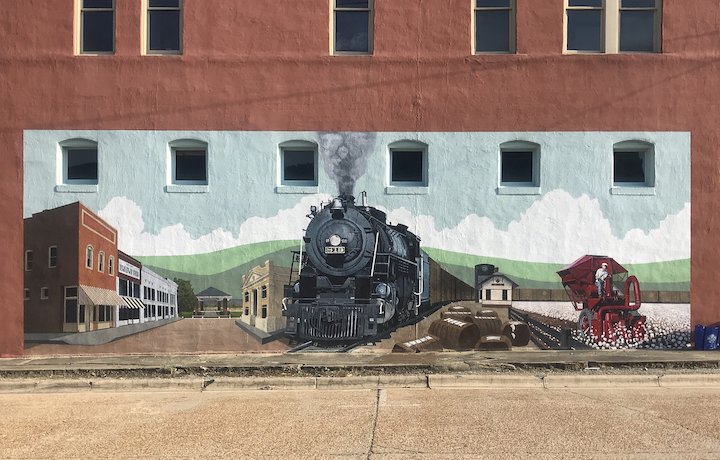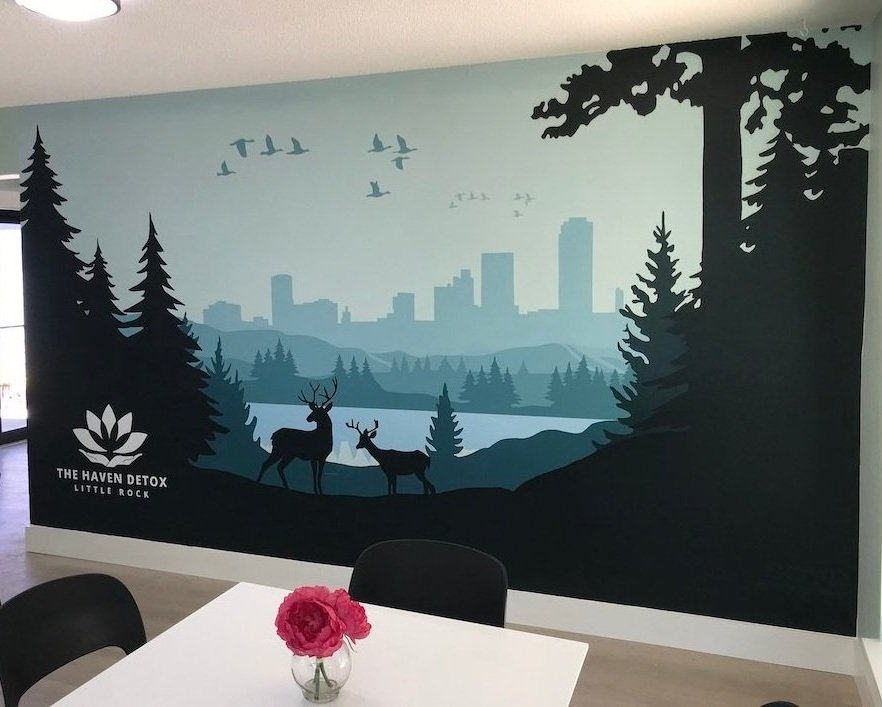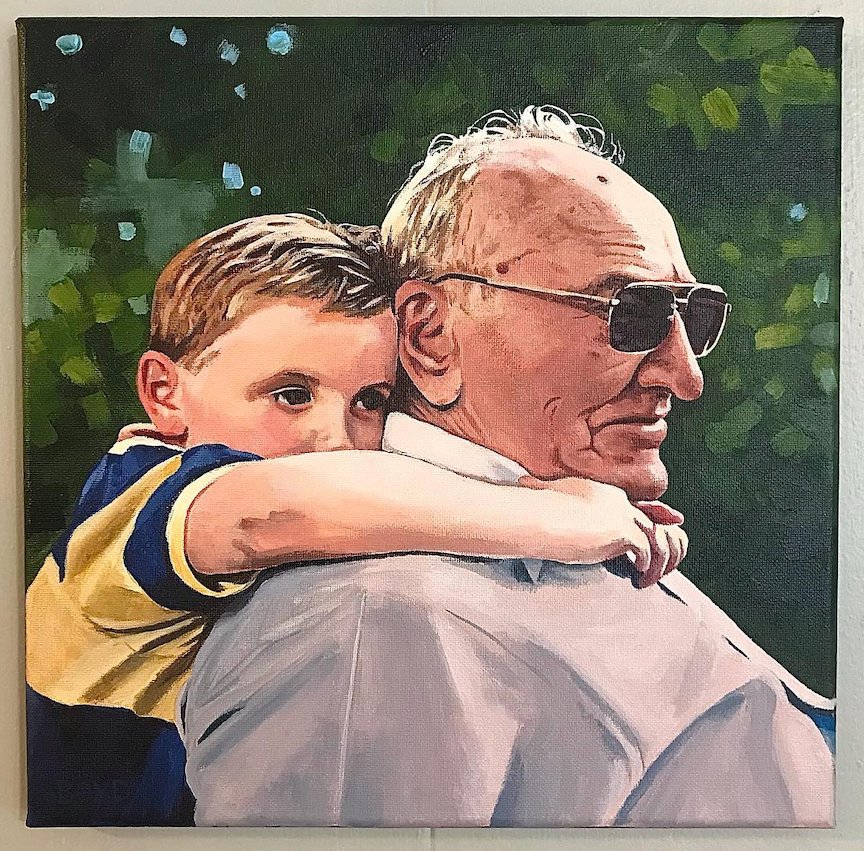Interview with artist Joel Boyd
Joel Boyd is a Little Rock fine art painter and muralist. He grew up in Rector, Akansas, where he learned to value community and developed his love of the South. Joel earned a BFA in painting from Savannah College of Art and Design in 2010 and he and his family eventually settled in Little Rock. In addition to his art practice, Joel is a painting instructor at the Arkansas Museum of Fine Art. More of Joel’s work can be found at his Instagram and Facebook pages.



AAS: Joel, are you originally from Arkansas?
JB: Yes, I grew up in Rector, Arkansas, which is in the northeast corner of the state. Rector is a small rural community situated on Crowley’s Ridge of about 1800 people surrounded by fields of corn, cotton, rice and other crops. My mother’s side of the family lived out in the country of the Rector Community, where they owned acres of farmland. My early years of childhood were spent playing in creeks, riding four wheelers in gravel pits, exploring the woods, and riding my bicycle all over town.
In high school I was very active in my thespian troupe with all types of creative projects but it wasn’t until the eleventh grade that I began pursuing the visual arts with more of a focus and presented a portfolio of my high school artwork at the Savannah College of Art and Design in Savannah, Georgia. I ended up receiving a scholarship for performing arts that could be applied to any field of focus. I studied painting throughout my years at SCAD and loved every minute of it.
I graduated in 2010 and moved to Little Rock with my wife who was finishing her undergrad at UALR. During this time, I rented a studio from the THEA Foundation in Argenta and completed a few painting commissions. When she graduated we moved to Chicago for her to pursue a graduate degree from Dominican University, and I worked part time as a bank teller while taking on commissions here and there. In 2013 we were expecting our second child and had a desire to move back home closer to family. I learned that my high school art teacher was retiring at the end of the school year. I needed a full-time job to allow my wife to stay at home, so applied for the position and entered into the APPLE program for teacher licensure. We moved to Rector and I ended up teaching K-12 Art in two classrooms for the next six years.
At the end of the school year in 2019 my wife and I were both burnt out from teaching and began talking about doing something different. She ended up applying for a job in Little Rock at an Ed-Tech company. She got the job and we began uprooting our lives and transplanting to the big city!
AAS: When did you first discover you liked to paint?
JB: I would say my early experiences in high school allowed me to discover the joy of painting and the power of art. In my theater troupe I was able to paint sets, design costumes, design t-shirts, create set designs, and so much more. In my visual arts classes I especially remember falling in love with watercolor and really exploring the medium under the direction of my art teacher.
AAS: I want to ask you first about your murals. How did you get into painting murals?
JB: During my years as a K-12 educator making art was very much on the back burner, but I took commissions here and there. One of my clients was a business owner who operated the town’s drugstore on main street. She and her father had received a grant from Mainstreet Arkansas to assist in the restoration of their historic main street building. As a part of that project, she really wanted to have a mural painted on the side of the building. She approached me about the idea, and I had always wanted to paint a mural in my hometown, so I said yes, before I really even knew what I was getting into. I went above and beyond on this project because I knew I wanted it to be outstanding in every way. I was in over my head, but looking back it was worth it. I ended up spending two years working on the mural here and there on Saturdays and in the summer. It was a great experience and it taught me so much about the process of creating a mural. Above all I was grateful to be able to give this artwork to my community. So many people stopped and talked with me about memories they had with connections to parts of my mural scene. Public art is a very unique experience and I have greatly enjoyed the many interactions I have had in the different communities I’ve worked in.
AAS: City Dreamers in Little Rock is a spectacular mural. What is the story behind it?
City Dreamers, 1,700 sq. ft., acrylic and varnish, 6th and Spring St., Little Rock, AR
JB: Thank you. Not long after moving to Little Rock, I learned of an open call for mural artists from the Downtown Little Rock Partnership. It was a big job (1700 sq. feet), with a big payout. So, I decided to give it a shot. As I considered what kind of work would fit well at this location, my first thought was a large-scale portrait. The format of the wall was taller than it was wide and it had two walls as it was a corner, so I thought it would be great to have two faces. I knew I wanted the mural to make Little Rock residents proud, but also any Arkansas native who might be visiting the city. At this point I decided to feature two images within the portraits, one a scene of nature and one a skyline of the city. I was very inspired by the landscape photography of Paul Caldwell and Mitchell Grosky. I reached out to the photographers and shared with them my idea for the mural and they both gave me permission to use their photos as a reference for the painting. I was really happy with the design, but it very much felt like a shot in the dark as I had just arrived on the scene so to speak only a few months earlier. To my surprise, I got the gig! I was enthralled, and truly wasn’t sure if I could pull it off. I only had one month to do it. Nevertheless, I put on my game face and took on the challenge. What an experience! I learned to use a scissor lift, trained myself in using a commercial paint sprayer, and set a new pace for myself in completing a job at this scale. The mural turned out great and has been so well received from the Little Rock community. I have never been prouder than after completing that project. It was a great test of my ability, and it really opened my eyes to the opportunities in mural painting. To date I have completed five murals in Little Rock, several throughout Arkansas and two in Missouri. I had no idea that my hometown mural project would have propelled me into all of this, but it has been a great journey and I am grateful for all of it.
AAS: One of my favorites of your murals is the Journey of Hope Mural Project. It is so well done. How much creative latitude are you given in such a high-profile project?
JB: Thank you. The Hope mural project was just an excellent experience through and through. Beckie Moore, director of the Hope Chamber of Commerce had seen my mural City Dreamers in Little Rock and reached out to me about the project. The Hope Downtown Network had received a grant from the Department of Arkansas Heritage and was looking to pay tribute to several notable figures and subjects of Hope history. They provided me with several subjects for the artwork and I was tasked with bringing it all together in a design. Ultimately, I decided to break up the various subjects into three separate murals designed in the style of vintage sign paintings. This was well received and allowed for the artworks to fit right in with the existing vintage Coca-Cola sign on the brick wall of the Chamber of Commerce.
Journey of Hope Mural Project, 9’ x 12’ each, acrylic and varnish, 201 S. Main St., Hope, AR


AAS: I want to ask you next about your portraiture work. Are most of your commissions for portraits?
JB: My commission work ranges, but portraiture has always been a mainstay of my work for clients. My first commission out of college was a portrait and I enjoy these special projects still today. Oftentimes a client will approach me with an old photo that has seen better days with the hope I can transform it into a new work of art that will last for many years to come. My portrait projects are almost always a gift to a loved one, and I can appreciate the meaning behind their vision, and I always consider it an honor to bring these images to life.
AAS: Tell me about Mis Padres. There must be a story behind it.
Mis Padres, 18” x 24”, acrylic on canvas
JB: Mis Padres is such a special piece for many reasons. First of all, the client in this case was a good friend of mine, so from the start it was a special project. My friend was looking to take some very old photographs of his grandparents and have them brought together in one painting as a gift for his mother. The photographs were some of the only images his mother had of her parents, but they were not in good condition. I decided on the format of a diptych, since the photos were separate and from different times. I painted the portraits with the colors of the vintage black and white photos. I was really happy with how it all came together and hopeful it would be well received by his mother. After he surprised his mother with the painting, I am told the whole room was soon in tears. This piece has even more significance because the painting is now a part of his mother’s ofrenda/altar for Dia de los Muertos.
AAS: You have been teaching art for many years and to different types of students, but this must be an especially exciting time to be an instructor at the Arkansas Museum of Fine Arts. Tell me about the classes you teach.
JB: It absolutely is! I consider it such a privilege and an honor to be a part of all the exciting things happening in this inaugural year. I am currently teaching Introduction to Watercolor and Introduction to Acrylic, and later in the summer I will be teaching Introduction to Gouache. These introductory classes are great for beginners who are looking to explore these mediums and see what it is like taking a class at the museum.
AAS: I am guessing that growing up in rural Arkansas must still influence your work. I’m thinking specifically about Shirley’s Place. It is a wonderful painting. Tell me about it.
Shirley’s Place, 18” x 24”, acrylic on canvas
JB: This painting is a commission from one of my best hometown clients. It has been such a pleasure to continue to create new paintings that are set in my beloved hometown of Rector. Several years ago, Jamie reached out to me with a special photo she had taken of her son on his first harvest from his first field of cotton grown on his own, and from that first project I have been able to work on nine different paintings through the years. This particular piece was created as a gift for her mother-in-law. Jamie had provided me with several of her beautiful photographs of the house and the field of cotton, and a gorgeous sunset. This painting is a great example of the beauty of Rector, Arkansas. I grew up with sunsets like this filling the sky, and it was such a pleasure to work on this painting.
AAS: I remember Blue House, Little Rock from the 62nd Delta Exhibition. Unfortunately, that exhibition was virtual because of COVID, but it still must have been a thrill having Blue House, Little Rock included in the exhibition.
Blue House, Little Rock, 18” x 24”, acrylic on canvas
JB: Oh of course, it was such an honor. I have respected the Delta show for years, but never really been in the position to have any artwork to submit. My move to Little Rock was a big part of shifting to working full-time as an artist and I was just thrilled to have made it into the show. My painting Blue House, Little Rock, was the result of my interest to use a building as the subject of a painting, rather than a person, but I still think of this painting much like a portrait. I took several photos of interesting houses and buildings from around the city. I settled on this building because of its character. The house is weathered and old, the paint is faded and chipping, the frame is sagging, the screen on the window is hanging off. The house to me seems to stand as a remnant of the many years of lives lived here. It reminds me of the country house I lived in as a kid.
AAS: A large part of your art practice is commission work, both large scale public art installations and private art. To do that you must be good at working with clients and transfiguring their visions to a wall or canvas. Do you have any advice for artists who want to do more of that?
JB: You know to work with clients with various goals and visions, you really have to be willing to adapt. I would say the experience of working as a K-12 educator, gave me plenty of training in working with different personalities and perspectives. With commission work it is important to fully understand the vision of the client, ask plenty of questions, share ideas, but keep the vision of the client in focus. For artists who would like to take on commission work I would suggest seeking out publicized calls for artists, but also let people know you are open to doing this type of work. There is plenty of work out there, but you have to be open to it. You may take on a project that you don’t love but use it as an opportunity to grow and move forward. Every new commission I accept is a new challenge, and I have been made a better artist because of it.
AAS: Joel what’s up next for you?
JB: Well at the moment I am gearing up for a big new project of my own inspiration. For a while now I have been thinking about doing something with some old photographs from my grandmother's family collection. Over the years I have always been so curious about my family’s early days in Northeast Arkansas from these excellent vintage photos. The photos range from the late 1800s to the early 1900s. There are so many interesting scenes. I have decided I would like to transform these photos into large scale paintings, giving them new life and telling their stories to a much larger audience. It would be such a meaningful project for me, and I think it would be well received by the Arkansas art scene, and beyond. This scene of my family picking cotton is a great example from this collection. I imagine this piece very large, like 8 feet by 12 feet or something. At this scale the viewer could stand and look at the painting and it would feel like you are at the end of the row of cotton and you have been transported through time and space, and just for a moment you can share their experience. As I look at these old photos it’s almost as if they were taken to say, “Look, here we are, this was our life”. It would be such a special way to pay tribute to my ancestors, and in some way thank them for their life; their life led to my life, and I am grateful to them for that.
Speaking of being grateful, I wouldn't be where I am today without the support of many wonderful people who have encouraged me along the way. First, I give my thanks to the educators, Gail Burns, Carolyn Caldwell, Linda Waldron, and Becca Simmons. These inspiring ladies saw a future in me long before I did, and I am so grateful for their own passion which was transferred to me. The women of the Rector Women's Club played such a pivotal role in supporting me through my college years and I will be forever grateful to them. My grandmother Linda Greenway has been in my corner from day one, and her love and her life will carry me for a long time to come. My wife is my rock and my best friend. And last, I would like to say thank you to my mom. She was taken from us in 2021, and there is so much I wish I could go back and tell her. So, for now I'll just say, thank you for everything mom, I will never forget it.





